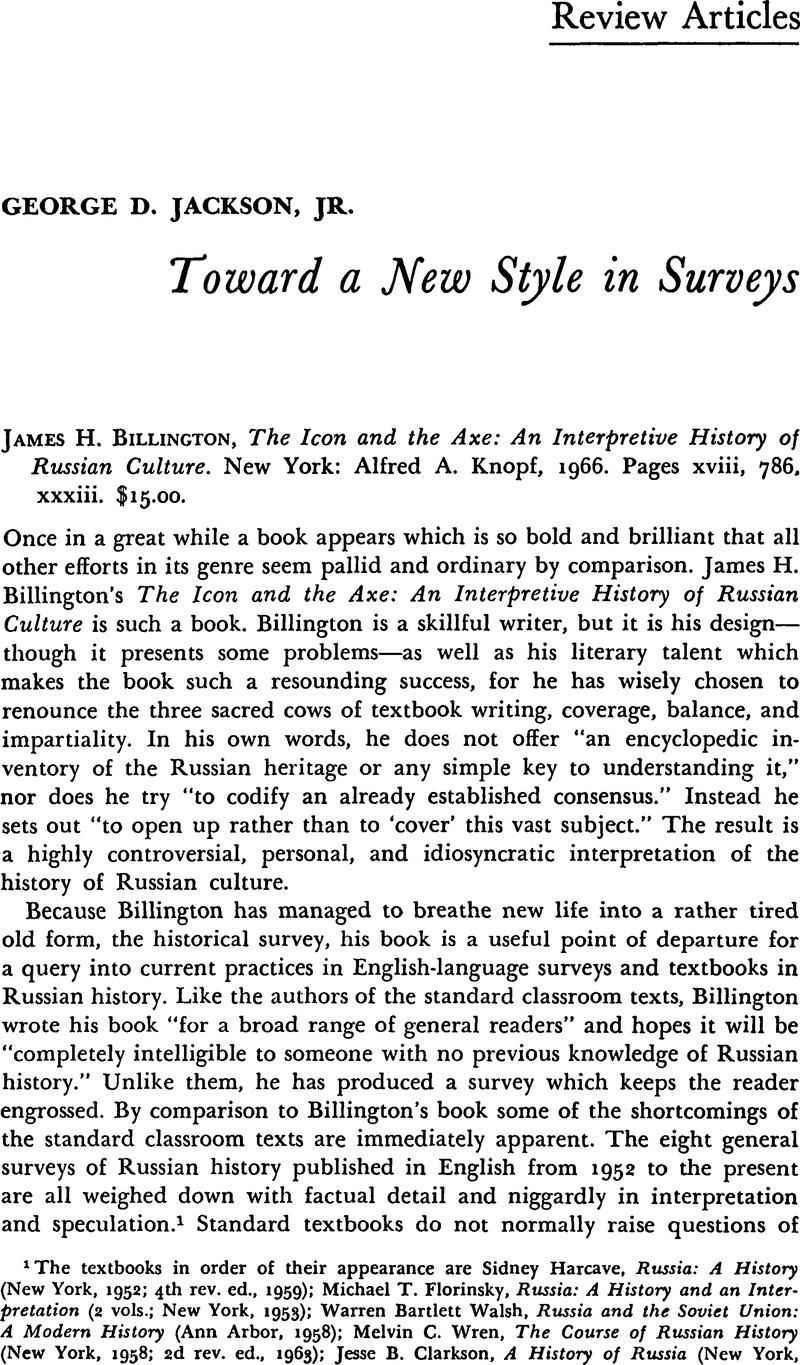Published online by Cambridge University Press: 27 January 2017

1 The textbooks in order of their appearance are Sidney, Harcave, Russia: A History (New York, 1952; 4th rev. ed., 1959)Google Scholar; Florinsky, Michael T., Russia: A History and an Interpretation (2 vols.; New York, 1953)Google Scholar; Walsh, Warren Bartlett, Russia and the Soviet Union: A Modern History (Ann Arbor, 1958)Google Scholar; Wren, Melvin C., The Course of Russian History (New York, 1958; 2d rev. ed., 1963)Google Scholar; Clarkson, Jesse B., A History of Russia (New York, 1961)Google Scholar; Riasanovsky, Nicholas V., A History of Russia (New York, 1963)Google Scholar; Ellison, Herbert J., History of Russia (New York, 1964)Google Scholar; Florinsky, Michael T., Russia, A Short History (New York, 1965)Google Scholar. These are the only completely new general surveys to appear after 1951. Short outline histories, revised editions of older textbooks, and new surveys limited to narrower topics or periods dian Billington's book are not included.
2 A dull and pedestrian style may be standard for most textbook writing, but even when it verges on the incomprehensible, reviewers seem inclined to refrain from comment. A good illustration is provided by Clarkson's book, which, although well conceived and excellent in many respects, is badly written and poorly edited. See, for example, the clumsy and convoluted discussion of the Stolypin reforms (Clarkson, p. 399). Yet in reviews of the book no comment was made on the defects of writing. Florinsky even went so far as to say, “A History of Russia by Dr. Clarkson is a more informative and better written book than the several texts in Russian history which have been published in this country in recent years“ (Political Science Quarterly, Dec. 1962, p. 626).
3 Walsh, Wren, Harcave, Clarkson, and Florinsky (in his one-volume survey) devote a third of their books to the Soviet period, Ellison a half. The only exception is Riasanovsky, who devotes one fifth of his textbook to the Soviet period. In his two-volume textbook Florinsky does not treat the Soviet period at all.
4 The dependence of most textbook authors on available English-language secondary sources can be seen even in skimming the sections of their books devoted to the origins of the Kievan state. They often rely exclusively on Vernadsky's work on this period, demonstrating little or no awareness of the controversies surrounding the subject or of the work of Soviet scholars. Ellison not only provides a summary of Vernadsky's views but also accepts without reservation two of Vernadsky's most dubious theories, his etymology of the word Rus’ and his assumption that in southern Russia in the eighth century there was a “Scandinavian commercial state” with its capital at Tmutorokan (Ellison, pp. 12-13).
5 Slavic Review, XXI, No. 4 (Dec. 1962), 737.
6 Those who argue that no historical canvas is large enough to encompass so much should consult William H. McNeill's The Rise of the West: A History of the Human Community (Chicago, 1963).
7 One can test this by consulting the indexes of the textbooks printed after 1951. With the possible exception of Riasanovsky, they devote little space to Siberia, the Urals, Poland, Lithuania, or Belorussia. They do not treat Central Asia or the Far East at all except in connection with foreign policy. Where comparisons between Russia and Western Europe would seem most relevant, as, for example, in the development of the new monarchies or the aristocracy, they are not pursued.
8 Marc, Bloch, Feudal Society (Chicago, 1961), p. 443 Google Scholar.